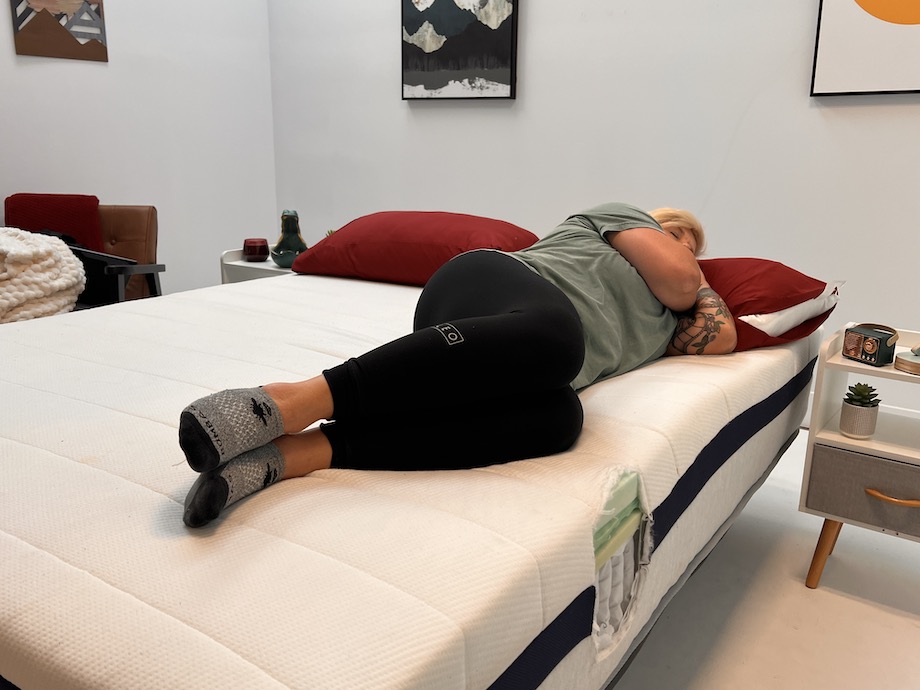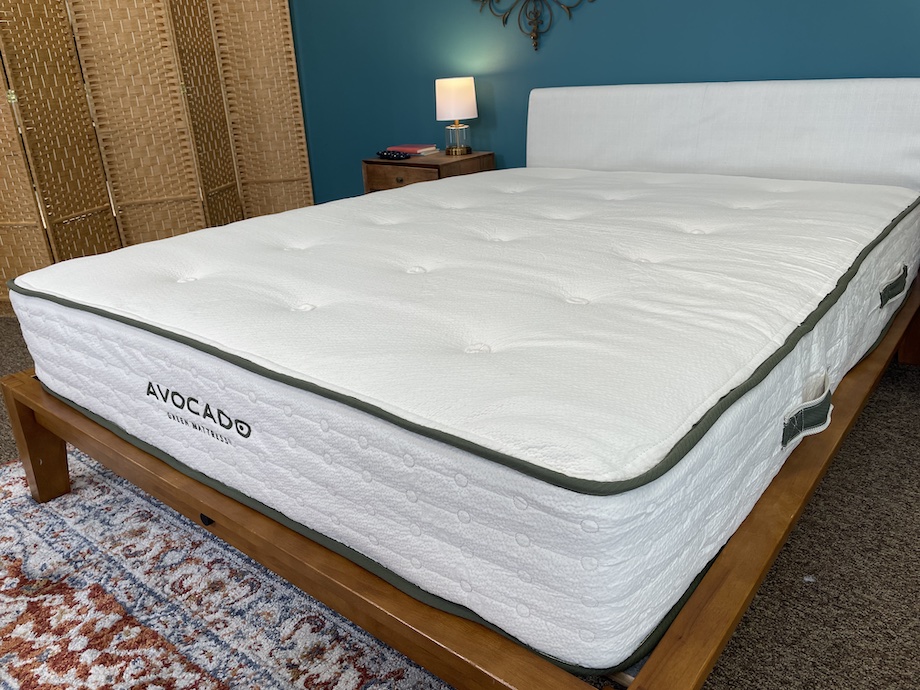If you’re shopping for a new mattress, you’ve likely come across the terms “latex” and “hybrid” mattresses at this point. Both are growing in popularity – and for good reason. These mattress types share valuable features like cooling, pressure relief, durability, and support.
That raises the question, then, as to which one is better. The answer to that will depend on your unique needs and preferences.
What Is a Hybrid Mattress?
A hybrid mattress is a combination of two different styles of mattresses. They’re made with both innerspring coils and foam, giving you both the support of the coils and the comfort of foam.
Hybrid Mattress Construction
Comfort Layer
The comfort layer of a hybrid mattress is the one on top, closest to you, and it’s usually optimized for pressure relief. You’ll often find memory foam in this area, but this can vary depending on the brand since some may use their own proprietary comfort foams. In some cases, you may find latex here too.
Transition Layer
The transition layer lies between the comfort layer at the top and the firmer support core below. This layer can either be made of the same or different material as the comfort layer, but it will usually be slightly firmer than the topmost layer. We often see poly foam in this area.
Support Core
The support core is made up of coils. Usually, these are pocketed coils, which means each coil is wrapped in fabric (versus interconnected coils found in innerspring beds). As a result, each coil moves independently, adapting to your body and creating more motion isolation than interconnected coils would.
Base
The bottommost layer of a hybrid mattress is the base. This layer acts as a stabilizer for the support coils above it and is usually made of highly dense poly foam.

Pros and Cons of a Hybrid Mattress
Hybrid Mattress Pros
- Temperature regulation – The pocketed coils in hybrids provide more airflow. Companies will also add other helpful features, such as cooling gel in the foams or temperature-regulating covers like cotton or Tencel.
- Motion isolation – Hybrid mattresses are better than traditional innerspring beds at isolating motion because of the pocketed coils and top foam layers that absorb impact. This means co-sleepers aren’t as likely to disturb their bedmate if they move around at night.
- Edge support – Edge support is the amount of support that a mattress provides at its edges so that you can sit or sleep comfortably there. Most hybrid mattresses provide good edge support, often using reinforced coils or foams to enhance this.
- Responsive – A mattress’s responsiveness is how quickly and to what degree it responds to your movements. This is often helpful for combo sleepers, anyone with limited mobility, and sexually active couples. A hybrid has coils, so it is typically more responsive than a memory foam mattress.
- Durable – Hybrids are considered more durable than traditional innerspring mattresses because of their top foam layers. These prevent the springs from poking through after a year or two. Most hybrids are expected to last an average of seven to 10 years.
Hybrid Mattress Cons
- Heavy – The combination of both foams and coils makes hybrid mattresses heavier and bulkier, which can make them harder to move.
- More expensive – While hybrid mattresses are generally less expensive than latex mattresses, they are still typically more expensive than memory foam or innerspring models. Some hybrid mattresses cost less than others, but a quality model could run you at least $1,200.
- Some motion transfer: Hybrid mattresses are better at isolating motion than traditional innerspring mattresses, but you may still experience some motion transfer because of the coils. A mattress with no springs, like a memory foam mattress, will often have even better motion isolation than a hybrid.
What Is a Latex Mattress?
Latex mattresses are rubber foam mattresses, meaning at their core, they are made from a rubberized material that has been whipped into a foam. This material is then molded and cured in sheets that are stacked on top of similar materials or integrated with others.
Types of Latex Mattresses
| Latex Type | Description |
|---|---|
| Natural | Latex mattresses come in three basic varieties: natural, synthetic, or some combination of the two. Natural latex is what it sounds like – it’s made from natural components, rather than being man-made like synthetic rubber is. Natural mattresses will cost more but usually last longer and don’t smell of rubber after you unpack them. Plus, they are environmentally friendly. |
| Synthetic | Unlike natural rubber, which is tapped from rubber trees, the rubber used in synthetic latex mattresses is a man-made creation and comes from petroleum. The biggest benefit to buying synthetic is the difference in price point since these are much cheaper than naturally made latexbeds. However, synthetic mattresses aren’t environmentally friendly and can have a strong, rubbery odor, especially in the first few days. |
| Dunlop | Dunop refers to a type of production process for latex. To make Dunlop latex, the first step is to tab rubber trees and gather liquid latex. This material is then whipped up, placed into a mold, and heated to create one large, continuous piece of rubber foam. Dunlop mattresses tend to feel firmer, though inconsistent. |
| Talalay | Unlike the Dunlop production method, only some of the latex is poured into the mold. This means the latex can expand and then the air is extracted, which gives Talalay an open-cell structure for more airflow. The next step is to flash-freeze the latex and split it into multiple sections, which are then glued together. Talalay mattresses tend to feel softer but can have seams. |
Latex Mattress Construction
Comfort Layer
The comfort layer is the one closest to the sleeper. The latex here is made through the Dunlop or Talalay process. A Talalay comfort layer is more popular, however, because it tends to be softer and more uniform in texture.
Support Base
The support base can be made either in the Dunlop or Talalay process as well. This layer is beneath the top comfort layer and is more dense. Dunlop lends itself well to this area as it tends to be a firmer, denser material.

Pros and Cons of a Latex Mattress
Latex Mattress Pros
- Cooler – These mattresses tend to sleep cooler, especially Talalay mattresses because they have an open-cell structure.
- Hypoallergenic – Latex mattresses are inhospitable to common allergens like dust mites, mildew, and mold. That said, be sure you don’t have a latex allergy if you are looking into this type of mattress!
- Eco-Friendly – Natural or organic latex mattresses are among the most eco-friendly since they are made from naturally tapped rubber. Keep an eye out for the GOTS and GOLS labels too, which will let you know if it is truly a sustainable mattress.
- Durable – Latex tends to be more durable than other types of mattresses. While an innerspring or even hybrid mattress might last about seven years, a latex mattress could last anywhere from 15-20 years, depending on the quality of materials and how you maintain it.
- Responsive – Latex mattresses tend to be highly responsive, which means they quickly adjust to your movements and respond accordingly. Buoyant mattresses are great for those with limited mobility, sexually active couples, or combination sleepers because they foster easier repositioning.
Latex Mattress Cons
- Expensive – A major downside to latex is the price, particularly for natural latex beds, which often cost upwards of $2,500 for a queen model. To lower the cost, consider a synthetic or blended mattress, which offers many of the same comfort benefits as a natural one. Also, shopping online might provide you with better deals and eliminate some of the supply chain costs.
- Motion Transfer – Latex is a naturally bouncy material, which means that it might transfer more motion when somebody moves on the bed. If you are a light sleeper and somebody moving next to you tends to disturb you at night, latex might not be the best option for you.
- Heavier – Latex tends to be a heavier material than other foams used in mattresses. You can expect a latex mattress to weigh anywhere from 90 to 125+ pounds, depending on the mattress size and density.
Comparing Latex and Hybrid Mattresses
| Latex Mattresses | Hybrid Mattresses | |
|---|---|---|
| Cost | 💰💰💰 – 💰💰💰💰 | 💰💰 – 💰💰💰 |
| Materials | Latex foam | Memory foam, poly foam, or latex foam steel coils |
| Average Lifespan | 15-20 years | 7-10 years |
| Advantages | Cooling, responsive, durable, and often more eco-friendly | Enhanced support, long-lasting, motion control, and more variety of designs |
What Are the Similarities and Differences Between Latex and Hybrid Beds?
Similarities
Cooling
Both types of mattresses are cooling. Hybrid mattresses are cooling because of the airflow between their pocketed coils, whereas latex mattresses stay cool because of their open cell structure (especially Talalay mattresses.)
Multiple Firmness Options
Both types come in multiple firmness options. While hybrids with memory foam are more body-contouring, hybrids with latex can feel more responsive. Purely latex mattresses can vary in firmness depending on how they were made: Dunlop-manufactured beds tend to be firmer and Talalay-made ones feel softer.
More Expensive
Hybrids have multiple layers and components, which makes them more expensive. Natural latex is also an expensive material to harvest and process. With either of these mattresses, you will likely pay anywhere from $900-$5,000.
Heavier
You’ll likely need extra help when trying to carry a hybrid or latex bed. The multiple layers in a hybrid make it a heavier mattress. Latex (either synthetic or natural) is a dense material, which makes for a heavier mattress.
Compatible With Different Bases
Both types of mattresses work well with different bed bases, including adjustable beds, platform beds, and foundations.
Differences
Feel
A hybrid mattress will have some buoyancy, but lying on it, you’ll mostly feel contouring, especially if it has memory foam. A latex mattress, on the other hand, should feel highly responsive because latex is a naturally bouncy material.
Motion Isolation
If a hybrid mattress’s comfort layer is memory foam, it will do a better job of isolating motion. Latex is a dense material, but it is also a buoyant one. This means latex typically doesn’t isolate motion well.
Lifespan
A hybrid has coils, and coils tend to break and lose their bounce after about seven years. Compare this to a latex mattress, which could last up to 20 years in some cases.
How Do Latex and Hybrid Beds Perform for Different Body Types and Sleep Positions?
Lightweight Sleepers (less than 130 pounds)
Typically, lightweight sleepers prefer softer mattresses. Latex mattresses can provide great pressure relief but tend to be firmer. In this case, hybrid mattresses with a memory foam comfort layer and a medium or plush firmness might be best.
Average-Weight Sleepers (130-230 pounds)
If you’re an average-weight sleeper, you’ll likely do well with either type of mattress, but we recommend a medium to firm one, depending on your sleep position. For example, if you’re a stomach sleeper, a firmer feel should suit you best.
Heavy Sleepers (more than 230 pounds)
Heavy sleepers need firmer mattresses with robust support for proper body alignment. While latex is typically a firm material, hybrid mattresses have extra support from the coils. In this case, you might find that the pushback from the coils and the added support from the foams work well for you.
Couples
If you are part of a couple, a hybrid mattress might be the better option for you. This is because they tend to have better motion isolation than latex mattresses, particularly if they contain movement-absorbing memory foam for fewer nighttime disruptions.
Side Sleepers
Side sleepers need a softer and more contouring mattress than stomach or back sleepers do. This means that firmer, bouncier latex mattresses may not be your best fit unless you can find a softer model. Generally, softer hybrid mattresses with a memory foam comfort layer will provide the plush pressure relief needed for sleeping on your side.
Back Sleepers
Back sleepers can be a great match for either latex or hybrid beds since they can get both support and pressure relief from either type. Most back sleepers should look for a latex or hybrid bed with a medium-firm feel that provides the right balance of pressure relief and support.
Stomach Sleepers
Stomach sleepers need a mattress that keeps their midsection from dipping. We recommend a Dunlop latex bed or a firmer hybrid mattress. When you shop, search for a mattress with at least a 7 out of 10 firmness rating.
Combination Sleepers
Combination sleepers do well with mattresses that have more bounce so they don’t feel stuck trying to move around at night. The bouncier latex mattress might be your best bet if you’re a combination sleeper. You may also consider a hybrid mattress with a latex comfort layer, rather than memory foam on top for added responsiveness.
Who Should Get a Latex Mattress?
- Luxury shoppers – Natural latex tends to be the most expensive mattress material, and you can expect to spend more on a latex mattress.
- Hot sleepers – Latex is naturally cooler and shouldn’t trap heat like other types of foam.
- Combo sleepers and those with limited mobility – Whether you have mobility issues or are a combination sleeper, latex might be a good option for you since it is naturally quite bouncy for easier repositioning.
- Eco-friendly shoppers – Natural latex is a more sustainable material, and many latex beds also incorporate other organic or natural materials in them.
- Sleepers with allergies – Latex mattresses are more hypoallergenic, making them great for folks with allergies.
Who Should Get a Hybrid Mattress?
- Sleepers with joint or back pain – Many hybrids combine a layer of coils with memory foam to both support the spine and provide pressure relief for the joints.
- Hot sleepers – Hybrids can also be helpful for hot sleepers because they include a layer of coils, which allows air to flow through the mattress. Many hybrids will also have cooling foams and breathable covers for further temperature regulation.
- Shoppers on a tighter budget – Both latex and hybrid beds can be expensive, but of the two, you’re more likely to find a lower price on a hybrid bed.
- Couples – Hybrids tend to have better motion isolation than latex beds. This means that if you share the bed with someone, you’re less likely to feel their movements through the night. Plus, the coils still give couples some buoyancy for more enjoyable sex.
- Heavy sleepers – Heavy sleepers may benefit from the enhanced support coils can provide. Just make sure you’re not going with a mattress that is too soft, which likely won’t be supportive enough for heavier folks.
Frequently Asked Questions
How do you know if a latex mattress is natural?
You can find out if a latex mattress is natural by checking the product label. If it is made with natural latex, it should say so. Be on the lookout for labels like GOTS or GOLS, which will let you know that not only is the mattress natural, but it was made in a socially and environmentally-responsible way. Most companies will advertise that the latex in their product is 100 percent natural. If they do not, this could mean their latex is synthetic or blended.
You can also put the mattress through some at-home tests yourself. First, smell the mattress; synthetic latex tends to have a rubbery, more chemical smell, especially when it is brand new. Then try bending the mattress; a natural latex mattress should fold in half, whereas a synthetic one might not. Third, attempt to lift the mattress safely; a natural latex mattress will likely be heavier than a synthetic one.
Are hybrid or latex mattresses more durable?
Latex and hybrids are two of the most durable mattress design, but In general, latex mattresses are considered more durable than hybrids. This is because hybrid mattresses have coils, which will wear out faster than a latex mattress with no coils. A hybrid mattress usually lasts about 7 years, compared to a latex mattress which can last up to 10 or more.
Is latex a hybrid mattress?
A latex mattress is not a hybrid mattress. However, some hybrids have latex comfort layers, and in many cases, these beds will be included under the latex mattress umbrella. For the basis of this comparison, though, we are focusing on latex beds that have an all-foam construction.
Is a latex or hybrid mattress better?
This will depend entirely on your body type, sleep position, and other preferences. For those who need a firmer, more bouncy mattress, latex might be the best solution. Couples, side sleepers, and those who prefer a mattress that is more contouring will likely enjoy a hybrid more. The good news is that online companies give lengthy trial periods so you can try out the mattress you’re interested in for yourself and see what’s the better fit.
Are hybrid mattresses healthy?
Hybrid mattresses provide great support and can help maintain proper spinal alignment and relieve pressure from the shoulders. This is because of the combination of both coils and foam. They’re also breathable and sleep cooler than a memory foam mattress. [
Is latex a good material for mattresses?
Latex is a great material for a mattress, especially when it comes to long-term comfort and durability. These types of mattresses can last 10 years or more, which is significantly more than other types of mattresses. Natural mattresses are also sustainable and an excellent choice for eco-conscious shoppers.
What bed is best for people with allergies?
Latex mattresses are a great option for people who live with allergies because this material is naturally resistant to dust, mildew, and mold. However, some people have latex allergies that can be severe. Before purchasing a latex bed, you’ll want to find out if you have a latex allergy.
Explore our picks for the Best Mattresses for Allergies.
Is a hybrid mattress good for back pain?
Hybrid mattresses offer fantastic support from individually-wrapped coils that move independently, adjusting to your body for superior comfort and motion isolation. They also have several layers of foam to provide added support and pressure relief. As a result, they should do a great job of keeping your spine in good alignment to improve your back pain and prevent it from worsening. Some hybrids are even made with special zoned support layers that can offer advanced comfort for those with back pain.
To Wrap It Up
Choosing the best mattress is certainly not a one-size-fits-all process. If you’re looking for a bed that feels bouncy, cooling, and may cost a bit more but is eco-friendly, a latex mattress might be your best bet. If you’re looking for something that has more support and pressure relief and works well for couples, you should consider a hybrid. Either way, both mattress types are generally high-quality, durable picks.
The Advisor Says
When shopping for a new mattress, pick something with a sleep trial of at least 90 to 100 nights and free returns or exchanges. This should help take some of the pressure off you to get it right the first time!

Natalie Grigson
Writer
About Author
Natalie is a content writer for Sleep Advisor with a deep passion for all things health and a fascination with the mysterious activity that is sleep. Outside of writing about sleep, she is a bestselling author, improviser, and creative writing teacher based out of Austin.
Side Sleeper
